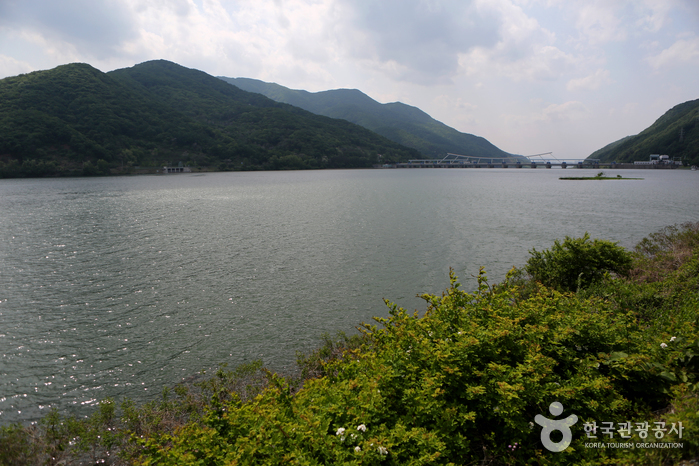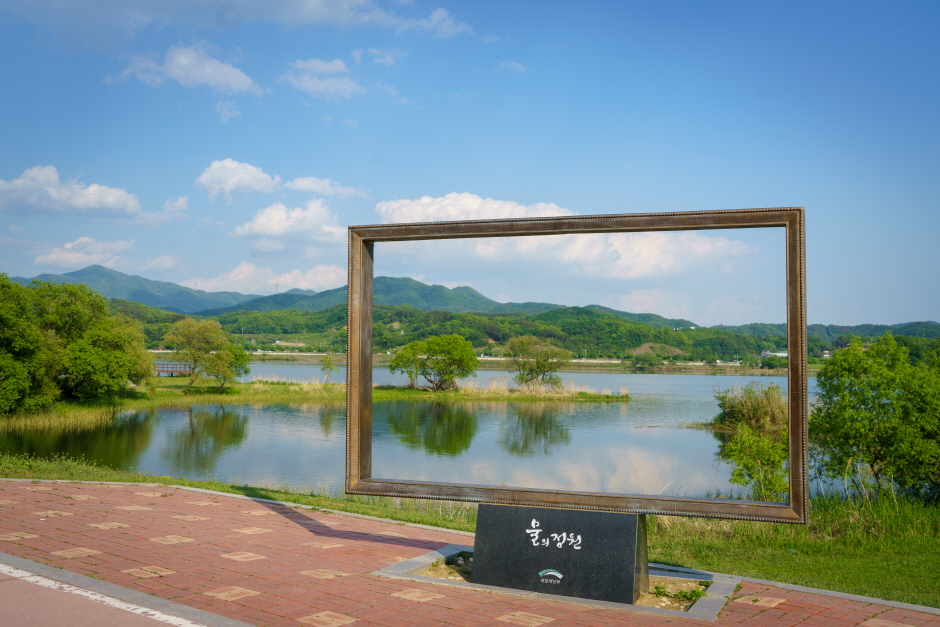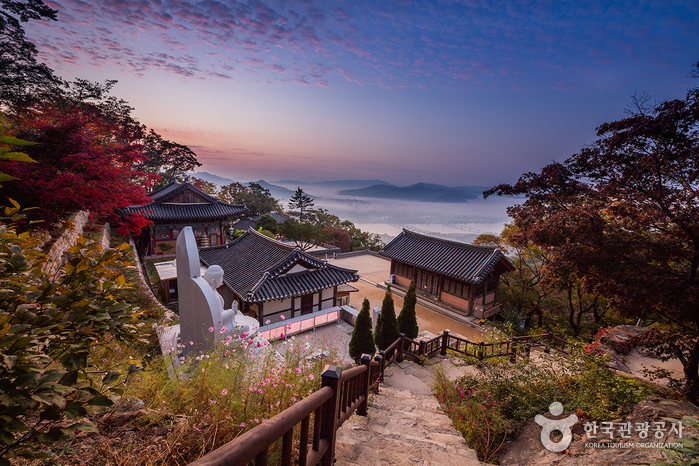Paldangho Lake (팔당호)
12.3 Km 10349 2021-05-25
Namjong-myeon, Gwangju-si, Gyeonggi-do
+82-31-760-2000
Paldangho, a man-made lake, lies beside the townships of Toechon-myeon and Namjong-myeon in Gwangju-si, Gyeonggi-do. Completed in 1973, this reservoir stores approximately 250 million tons of water, which is supplied to the Seoul and Gyeonggi regions. It is also one of Gwangju's tourist attractions, offering an inspiring view and a scenic lakeside drive. Don’t miss a stop at the Paldang Observatory for a breathtaking view of Paldangho Lake.
Water Garden (물의정원)
12.4 Km 3 2023-07-27
398 , Bukhangang-ro, Namyangju-si, Gyeonggi-do
Namyangju Water Garden was created as a waterside ecological park with a vast area of 484,188 ㎡ created by the Ministry of Land, Infrastructure, and Transport as part of the Hangang River Restoration Project in 2012. For residents living nearby, the water garden is a neighborhood park visited to enjoy jogging and riding along the promenade and bicycle path. It is also a great tourist destination for travelers.
Sottukkeong Dak Bokkeumtang (솥뚜껑닭볶음탕)
12.4 Km 33426 2024-02-15
130-18 Eobisan-gil, Seorak-myeon, Gapyeong-gun, Gyeonggi-do
Spicy Braised Chicken, a staple in Korean cuisine, is prepared by stewing chicken pieces with a fiery blend of red pepper powder and various seasonings. It’s a dish that complements rice perfectly. Here, the chicken is simmered in a sizeable metal pot with a flat lid, a method that not only retains heat better but also infuses a distinctive flavor and a touch of the chef’s personal care into every bite. The dish’s flavor is enhanced when paired with seasoned green onions, adding a crisp, spicy kick. Following the main course, the leftover sauce is used to stir-fry rice into the visually appealing and tasty Fried Rice Art, often shaped into a heart, delighting both the palate and the eyes. Nearby, guests can hear the gentle flow of a stream and have access to the valley via stairs, offering a chance to indulge in some light water activities after their meal.
Nuengnae Station [Discontinued Station] (능내역 폐역)
12.4 Km 0 2023-06-22
566-5 , Dasan-ro, Namyangju-si, Gyeonggi-do
Neungnae Station, located in Namyangju, was discontinued in November 2008 with the opening of Ungilsan Station. The station has been maintained as a monument, with some of the train tracks still in place. A bicycle path in front of the station connects Neungnae Station with the nearby Dasan Historic Site.
Namyangju Joan [Slow City] (남양주 조안)
12.5 Km 8295 2020-03-27
413, Bukhangang-ro, Namyangju-si, Gyeonggi-do
82-31-521-5686
The origin of the city name, Joan, comes from the meaning "a place where birds dwell peacefully." Joan-myeon in Namyangju was designated a "slow city" in 2010 and was the first slow city in the Seoul metropolitan area. The city has a well-paved bike road along the Namhangang Riverbank connecting Paldang to Yangpyeong through Daeseong-ri. The city also has the Slow City Trail, starting from Ungilsan Station and passing through Majinsanseong Fortress and Sujongsa Temple before arriving at Songchon Independence Park.
Each of the twelve villages in Namyangju is known for a different local treasure, ranging from lotus fields to cultural heritages. Joan-myeon in particular has received compliments for its local communities, eco-friendly and organic farming, natural environment, traditional culture, and well-managed fisheries.
Yongmunsa Temple (용문사(용문산))
13.4 Km 28282 2022-12-21
782, Yongmunsan-ro, Yangpyeong-gun, Gyeonggi-do
+82-31-773-3797
Yongmunsa Temple is located about 9 kilometers northeast from Yongmun Station on the Jungang line. It was built during the Silla Kingdom and reconstructed during the reign of King Sejong of the Joseon dynasty. It was badly damaged during the Korean War, but was restored and now consists of three buildings, the main hall, Daeungjeon Hall, and the bell tower. Its courtyard contains the largest ginkgo tree in Asia, which is 1,100 years old, measures 60 meters in x_height and 14 meters in circumference and is designated and protected as a Natural Monument. Legend says the great Buddhist Monk Uisang, who lived during the Silla Kingdom, stuck his staff in the earth, and the tree grew out of the simple staff.
The Restaurant (더 레스토랑)
13.9 Km 5032 2019-02-07
961-34, Yumyeong-ro, Seorak-myeon, Gapyeong-gun, Gyeonggi-do
+82-31-589-3457, 3305
Located within Ananti Club in Gapyeong, Gyeonggi-do, The Restaurant serves international cuisine made from fresh and organic ingredients. From 11:30 to 14:00, guests can enjoy the fresh salad bar with ala carte menu items. Please note that The Restaurant does not operate when the golf resort is closed.
Ananti Chord (아난티코드)
13.9 Km 16162 2021-05-21
961-34, Yumyeong-ro, Gapyeong-gun, Gyeonggi-do
+82-31-589-3000
Ananti Chord is a golf resort operated by the golf course leisure expert company Emerson Pacific. Ananti Chord was designed to blend in with the natural surroundings, x_heightening the aesthetic features of each component that make up the resort, including the golf courses, buildings, and nature. Although the golf course is exclusive to members only, Ananti Chord welcomes non-members to use the racket club, swimming pool, restaurants, and other amenities. Unlike other golf resorts that are closed for winter, Ananti Chord hosts winter activities every year for year-round entertainment.
Mijin Memil Maeul (미진메밀마을)
14.0 Km 4435 2024-02-23
783-1 Bukhangang-ro, Seojong-myeon, Yangpyeong-gun, Gyeonggi-do
Mijin Memil Maeul is a restaurant specializing in a variety of buckwheat-based dishes, using buckwheat produced in Korea. Some of its key menu items include memil mulmakguksu (cold buckwheat noodles) and memil bibim makguksu (spicy buckwheat noodles). Patrons can also enjoy memil mandu (buckwheat mandu) or memil jeonbyeong (buckwheat crepe) as side dishes to complement the noodles.
Sujongsa Temple (수종사)
14.0 Km 46276 2023-06-22
186, Bukhangang-ro 433beon-gil, Namyangju-si, Gyeonggi-do
+82-31-576-8411
Sujongsa Temple is a branch temple of Bongseonsa Temple, located near the top of Ungilsan Mountain. Amazing views from Sujongsa Temple include various mountaintops and the Bukhangang River. While records are not entirely clear, it is believed that the temple was built in 1439 during the Joseon period. The temple went through many reconstructions and expansions, but ultimately was entirely destroyed during the Korean War. In 1975, Monk Hyegwang began reconstructing the temple, starting with Daeungbojeon Hall and slowly expanded the temple site subsequently.



![Nuengnae Station [Discontinued Station] (능내역 폐역)](http://tong.visitkorea.or.kr/cms/resource/13/2724113_image2_1.jpg)
![Namyangju Joan [Slow City] (남양주 조안)](http://tong.visitkorea.or.kr/cms/resource/61/1720461_image2_1.jpg)

 English
English
 한국어
한국어 日本語
日本語 中文(简体)
中文(简体) Deutsch
Deutsch Français
Français Español
Español Русский
Русский